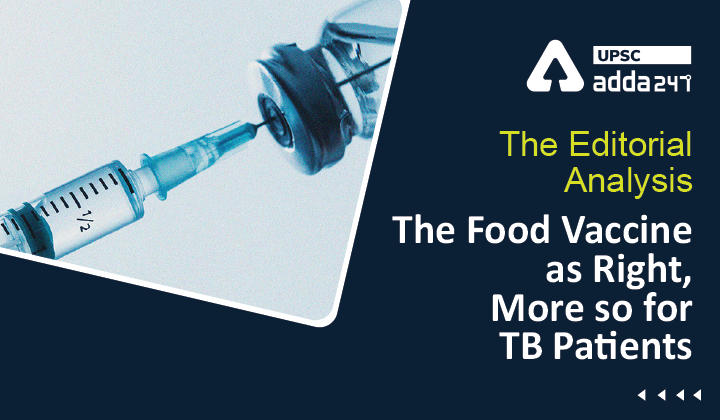Table of Contents
TB eradication UPSC: Relevance
- GS 2: Issues relating to development and management of Social Sector/Services relating to Health, Education, Human Resources.
Tone of the Editorial
- The editor is a former Director of the State Health Resource Centre (SHRC) Chhattisgarh. In this article, he explains how nutrition and TB are directly-related and why the vaccines must be supplemented with a balanced nutritional diet to eradicate TB.
संपादकीय विश्लेषण: फूड वैक्सीन सही है, टीबी के मरीजों के लिए और भी बहुत कुछ
History of TB cure
- Earlier, hospitals that had patients with longer duration of stay were set up in mountain terrain, with fresh air, pure water and good food, to cure TB.
- There were no drugs for TB till the discovery of streptomycin in 1943.
- Moreover, with improved wages, better living standards and the accompanying higher purchasing power for food, the TB mortality rate came down from 300 people per 1,00,000 population to 60 in England and Wales.
- Also, TB disappeared from socio-economically developed countries long before the advent of chemotherapy.
- After the Second World War, there was a reduction of 92% reduction in the incidence of TB among British soldiers who were fed an additional Red Cross diet of 1,000 calories plus 30 grams of protein when compared to Russian soldiers who were fed only a camp diet.
- This historical importance of good nutrition was ignored by the modern therapist who tried to control TB initially with streptomycin injection, isoniazid and para-aminosalisylic acid.
- In a quest of finding antibiotics killing the germs, the social determinants of disease were ignored.
Bacteria centric treatment
- With improved drugs like rifampicin, ethambutol, pyrazinamide etc., the fight against TB continued, which became multi-drug resistant.
- The continued focus on bacteria meant that the treatment were bacteria centric and not drug centric.
Nutrition and T.B
- J.B. McDougall of the World Health Organization (WHO) and Dr. René J. Dubos in the Journal of the American Medical Association said during 1950s that to prevent tuberculosis, the nutrition of an individual is of utmost importance.
- B is considered as a disease of the poor. It is because as WHO found, the poor are three times less likely to go for treatment and four times less likely to complete their treatment for TB.
- Even the work and the findings of a team at the Jan Swasthya Sahayog hospital at Ganiyari, Bilaspur in Chhattisgarh established the association of poor nutritional status with a higher risk of TB.
- The 2019 Global TB report identified malnutrition as the single-most associated risk factor for the development of TB.
- Due to the clear relation between nutrition and TB, many organisations began providing eggs, milk powder, dhal, Bengal gram, groundnuts and cooking oil to diagnosed patients along with anti-TB drugs.
- The state of Chhattisgarh also initiated the supply of groundnut, moong dhal and soya oil.
- From April 2018, under the Nikshay Poshan Yojana of the National Health Mission, all States began extending cash support of ₹500 per month to TB patients to buy food.
Way forward
- The food vaccine is a guaranteed right for life under the Constitution for all citizens, especially for the TB patients.
- Thus, the goals of reducing the incidence of TB in India and of reducing TB mortality cannot be reached without addressing undernutrition.
Read current affairs for UPSC





 TSPSC Group 1 Question Paper 2024, Downl...
TSPSC Group 1 Question Paper 2024, Downl...
 TSPSC Group 1 Answer key 2024 Out, Downl...
TSPSC Group 1 Answer key 2024 Out, Downl...
 UPSC Prelims 2024 Question Paper, Downlo...
UPSC Prelims 2024 Question Paper, Downlo...




